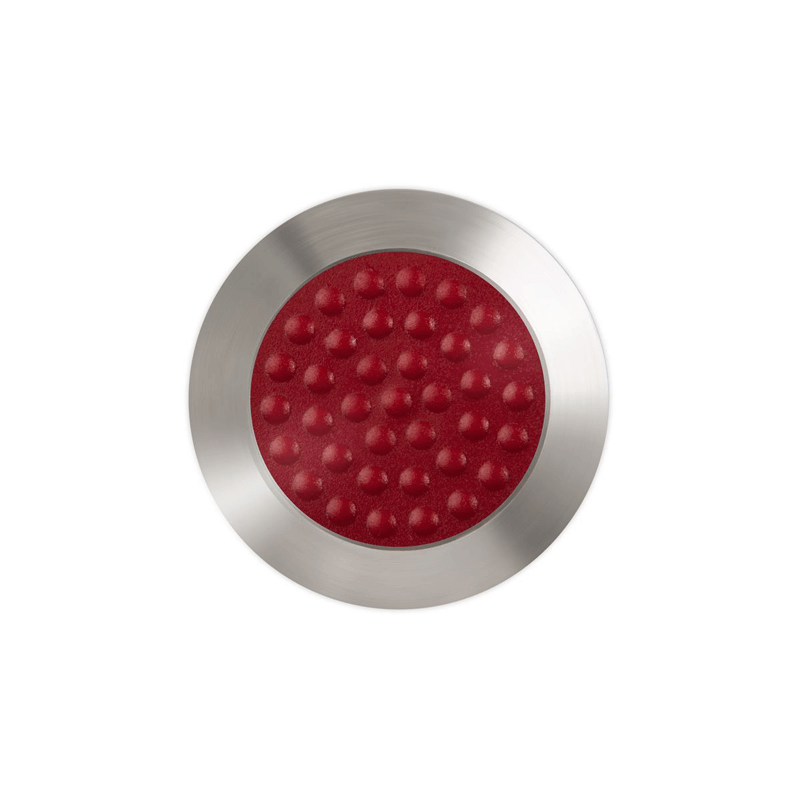There are multiple measurement of the level of grip provided by a surface including R-ratings and COF (Coefficient of Friction). R-ratings are the most commonly used and are often seen in domestic life when it comes to products like flooring tiles, patio tiles and vinyl flooring for example. These indicators are a great way of understanding how much grip is going to be provided subject to various circumstances. Anti-slip measurements are vital to consider when outfitting outdoor areas with tiles, studs or strips, to ensure the area is safe and easy to navigate. Employing the wrong tactile device or tile can often lead to a worsening of grip conditions and can even create a slip hazard.
What is the test that determines R-Ratings?
The test that determines an R-rating is called the DIN 51130 Shod Ramp Test. It was initially a German method of testing but has since been adopted worldwide as a universal indicator. The standard used is a cleated work boot traversing a surface with oil as the contaminating factor. Other factors that are taken into consideration during the test is the maximum slip angle achieved, ranging from 6 degrees to 35+ degrees. The R-rating is then derived from the relative success of traversal over the angled and oiled surface.
What other tests are used?
Some commonly used testing methods include-
DIN 51097 Barefoot Ramp
This test is very similar to the Shod Ramp test with the differences being that the test is performed barefoot, and the surface contaminant is water. This testing method is primarily used for things like tiles surrounding swimming pools and forms part of the guidance around their use.
The ratings are:
A – 12-18 degree angle – suitable for a changing room
B – 12-18 degree angle – suitable for a swimming pool’s surrounding area
C – <24 degree angle – suitable for ramps or steps that lead to water
BS7976 and the UNE ENV 12.633 Pendulum Test
Just as it sounds, these tests utilise a synthetic heel dropped from a right angle over a surface. This test measures the impedance of the surface and turns this reduction in momentum into a value. The key factor in this measurement is how far the heel travels post contact with surface. This measurement is then given a PTV Value of High, Moderate, Low and Very Low. This testing method is utilised by the HSE when performing investigations on slip accidents in industrial settings. They use a portable device to measure the value of the floor the accident happened on to determine it’s suitability and the culpability of a business.
BS7976 Pendulum Test Ratings
High – PTV value <25 – A high potential for a slip to occur and can be considered dangerous
Moderate – PTV value 25-35 – A moderate potential for a slip to occur and can be considered to present a moderate danger
Low – PTV value 35-65 – A low potential for a slip to occur and can be considered safe
Very Low – PTV value <65 – An extremely low potential for a slip to occur and can be considered very safe
UNE ENV 12.633 Test Ratings
0 – Dry/Indoor area usage only – PTV <15
1 – Dry/Indoor with a slope not exceeding 6 degrees 0 PTV 15 – <35
2 – Wet/Indoor areas like changing rooms, pool areas, bathrooms – PTV 35 – <45
3 – Wet and other lubricant/Indoor areas like industrial floors, garages, larger commercial kitchens and external areas – PTV >45
What are the R-Rating measurements?
R-ratings start at R9 and go all the way up to R13. There are no ratings below 9.
They are as follows:
R9 – A normal level of grip for surfaces with an incline between 3 to 10 degrees. Used within indoor areas that come across little water and are for most of the time dry, like an entrance to a building i.e., reception area.
R10 – A medium level of grip for surfaces with an incline between 10 to 19 degrees. Used for indoor and outdoor areas with minimal contact with water like external entrances, hallways and commercial areas.
R11 – A high level of grip for surfaces with an incline between 19 to 27 degrees. Used for both indoor and outdoor areas that will be subject to a lot of contact with water and will provide pedestrians with a decent level of grip despite conditions. Ideal for entrances to buildings both inside and out and general use on pathways.
R12 – A strong level of grip for surfaces with an incline between 27 to 35 degrees. Applicable to both indoor and outdoor use that will see heavy water or contaminants like oil, diesel etc. Great for use on pathways next to heavily used roads.
R13 – A very strong level of grip for surfaces with an incline greater than 35 degrees. Used for both indoor and outdoor areas providing the best grip profile for locations that see heavy surface contamination from the likes of water and other lubricants.
Which R-Rating should I choose?
Each measurement is applicable to various scenarios and it’s not always worth maxing out at an R-rating of R13 if all that is required is R9. Depending on what you’re trying to achieve often times a lower R-rating can be more desirable, especially as often there is an associated cost with the higher ratings as the likes of R12 and R13 are used in the most demanding use cases. The descriptions above should give you an idea of the appropriate use for each R-rating and often times R-ratings are specified based on HSE regulations for specific projects. While it’s important not to over value an R-rating, at the same time it’s important to get the correct one, especially if the scenario in which the device will be installed is a demanding one.

